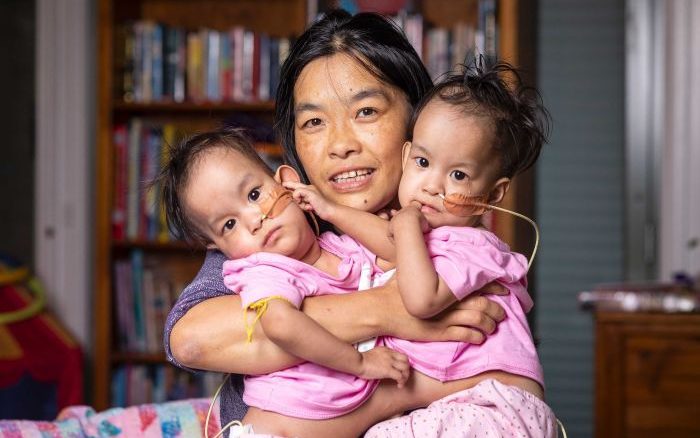
Conjoined twins Nima, Dawa undergo separation surgery in marathon procedure
A marathon procedure to separate conjoined 14-month-old twins Nima and Dawa is underway at Melbourne’s Royal Children’s Hospital, with doctors saying the operation is “all about the connections”.
Key points:
- The surgery was delayed for several weeks until the twins grew stronger
- The twins are believed to share a liver and possibly a bowel, doctors say
- The operation is expected to take a number of hours
The girls, who come from Bhutan, are joined from the lower chest to just above the pelvis, and it is believed they share a liver.
The surgery is being carried out by four surgeons and a team of about 18 people, and is expected to take a number of hours.
Joe Crameri, one of the paediatric surgeons involved in the operation, said he was confident it would be a success.
“I feel confident that we’ve built a team that can deal with this,” he told the media before the surgery began.
Dr Crameri said the operation “all comes down to the connections between the girls”.
“If they don’t share much of a connection beyond what we’ve seen in these scans then we could finish almost by 4:00pm,” he said.
“The first step is to position the girls so we can look at what are the structures that are connecting them.
“I think the other challenge will be the bowel and maybe sharing that.”
Dr Crameri said everyone was born with a lot of bowel.
“You can afford to decrease that [the bowel] without compromising how everything functions,” he said.
“So we’re hopeful we can deal with that challenge if it arises without compromising the girls to a major degree.”
###
Jim Acosta suspension: Sarah Sanders accused of sharing ‘doctored’ video to justify CNN ban
White House press secretary Sarah Sanders has been accused of sharing a “doctored” video which exaggerates the actions of CNN reporter Jim Acosta to justify suspending his credentials.
Key points:
- The video seems to show CNN reporter Jim Acosta pushing down on the arm of a White House intern
- Analysis of the video by Storyful shows it contains extra frames, which have been repeated
- The video was first shared online by a conspiracy theorist, who denies doctoring it
Acosta had his hard pass to access the White House grounds revoked hours after a testy exchange with US President Donald Trump during a press conference.
The White House said it was because Acosta put “his hands on” an intern who was trying to grab a microphone off him, while CNN said it was “retaliation for his challenging questions”.
The pair began sparring after Acosta asked Mr Trump about the caravan of migrants heading from Latin America to the southern US border.
When Acosta tried to follow up with another question, Mr Trump said “That’s enough!” and a female White House aide unsuccessfully tried to grab the microphone from the reporter.
Ms Sanders released a statement accusing Acosta of “placing his hands on a young woman just trying to do her job as a White House intern”, calling it “absolutely unacceptable.”
The interaction between Acosta and the intern was brief, and Acosta appeared to brush her arm as she reached for the microphone and he tried to hold onto it. “Pardon me, ma’am,” he told her.
Acosta tweeted that Ms Sanders’ statement that he put his hands on the aide was “a lie”.
But Ms Sanders later posted a video of the incident on Twitter, saying she stood by the decision to revoke Acosta’s pass and the White House would “not tolerate the inappropriate behaviour clearly documented” in the footage.
###
The little-known origin of the minute’s silence
Across the road from the Shrine of Remembrance in Melbourne, a humble plaque set in a constellation of rocks reads:
In memory of Edward George Honey who died in 1922, a Melbourne journalist who while living in London first suggested the solemn ceremony of silence.
Honey, who served during World War I, was the first to publicly suggest silence as a vessel to hold the sorrow and loss of war — and even thoughts of triumph.
The idea came to him after November 11, 1918 — when news of the Allies’ victory sparked rowdy euphoria in the streets of London.
Rather than celebrating, Honey’s thoughts turned to the colossal cost of the Great War.
“The world [had] been torn to pieces and he [was] clutching for a new vocab of remembrance,” says historian Bruce Scates from the Australian National University.
Honey found a vocab more powerful than any words: silence.
“Silence can mean something to everyone,” Professor Bruce Scates says.
“It’s an empty space you can fill with any thought you need to.
“But most important for Honey, what it’s saying is we can share this silence, even if you haven’t lost someone immediately close to you.”
The moment of silence filled a deep need in people to make sense of what had happened to them.
This weekly news roundup is curated with stories from ABC News.
SheSociety is a site for the women of Australia to share our stories, our experiences, shared learnings and opportunities to connect.

Leave a Reply